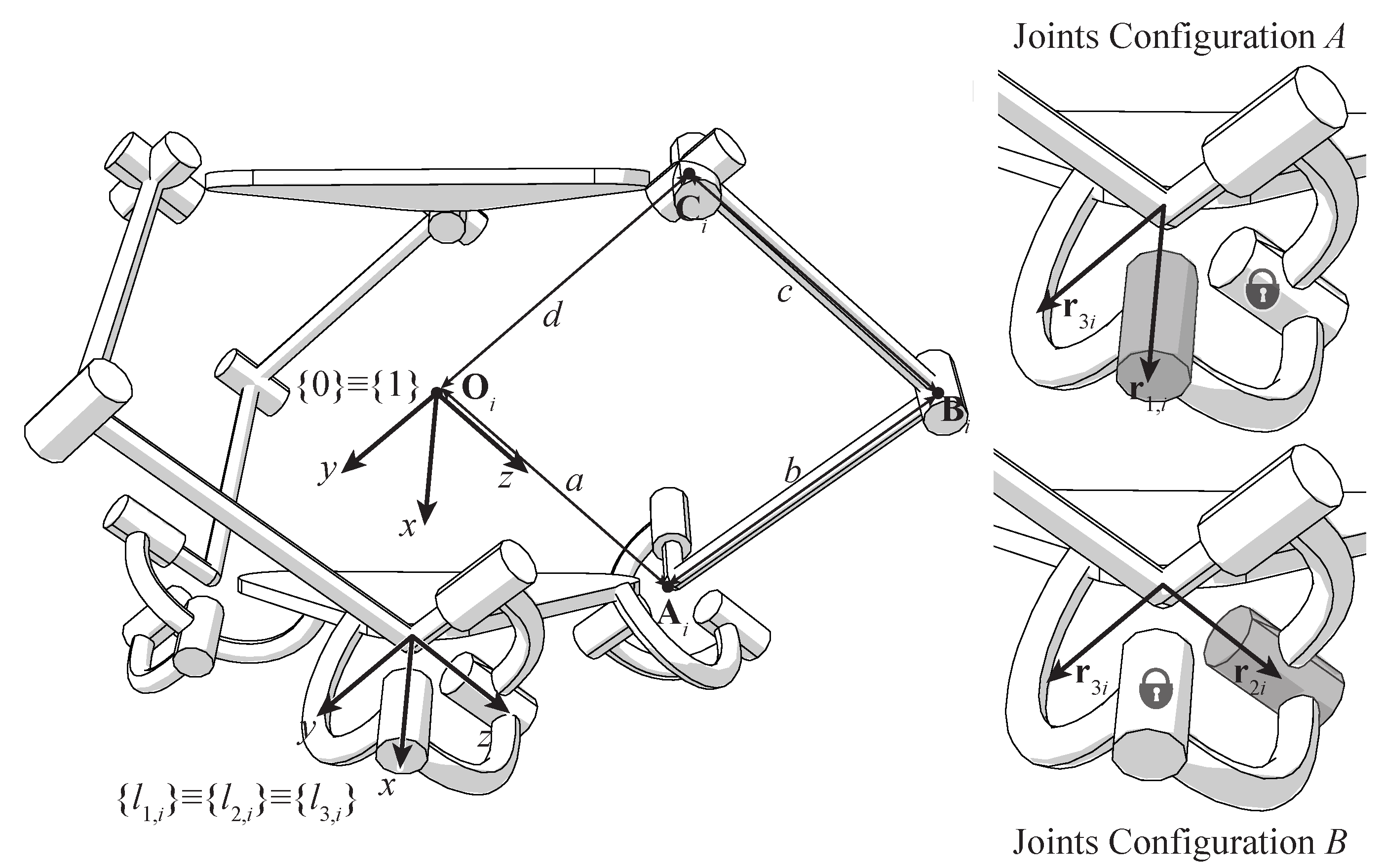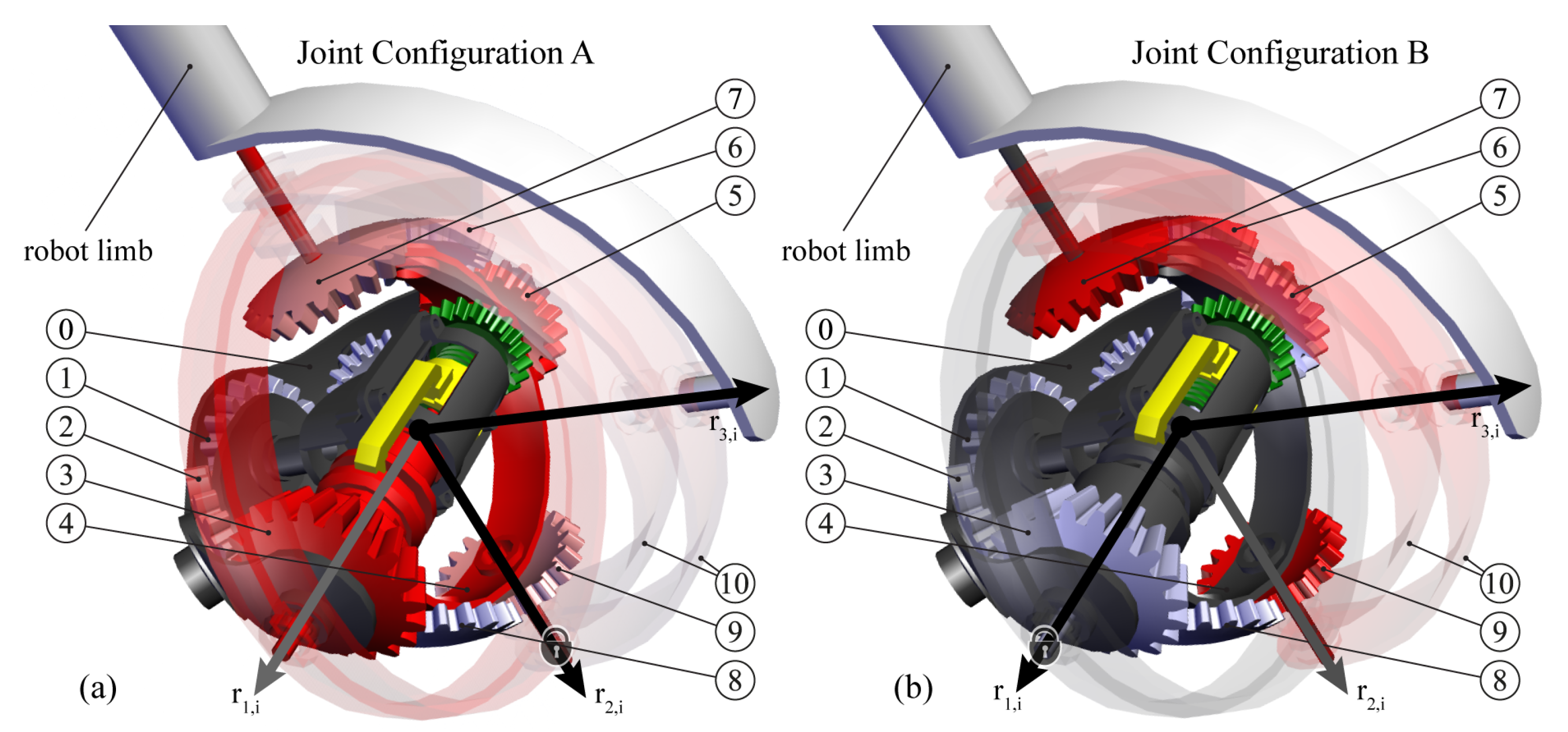Design of a Lockable Spherical Joint for a Reconfigurable 3-URU Parallel Platform
Abstract
:1. Introduction
2. The 3-URU Reconfigurable Robot
- -
- the first revolute joint is coaxial to the respective axis of the reference frame . In the i-th leg local frame the unit vector describing such axis is ;
- -
- the second revolute joint is perpendicular to the first one and it is directed along the first body of the limb at home configuration. In the frame it is ;
- -
- the axis of the third and last rotation is perpendicular to both axes of the first and the second rotations at home configuration. With respect to frame it is .
3. Conceptual Design of the Reconfigurable Joint
4. Functional Design of the Reconfigurable Joint
4.1. The Operational Principle
- -
- Joints Configuration A, Figure 4a: the actuator of the limb is fixed to the grounded body 0 (dark grey in figure) and it is connected to the bevel gear 1 which moves gears 2 and 3. In this configuration, the locking mechanism, which is described later, solidly connects the gear 3 to the body 4 (colored in red in Figure 4a). Thus, the rotation of gear 3 moves the robot limb around the axis , as required by Joints Configuration A. The gear 5, which rotates solidly with 3, does not affect the mobility since it is not connected to the body 4, as well as gears 6, 7, 8, and 9. The rotation around axis is restricted by the fact that gears 7 and 9 are always solid with the fork 10. Such gears rotate around by means of the motion of body 4, avoiding them to rotate around their own axes. Rotation about is no way controlled, as required by the robot kinematics.
- -
- Joints Configuration B, Figure 4b: in this configuration, the locking mechanism connects the body 4 to the ground 0, avoiding the rotation around . The actuation starts again from gear 1 and it is transmitted to 2, 3 and then to 8 and 9. In this case, the rotation of gear 9 puts in rotation the fork 10 around , as prescribed by the kinematics required by joints configuration B. Gears 5, 6 and 7 work exactly in the same way providing a symmetric actuation to the fork 10. Again, rotation about is no way controlled.
4.2. The Locking Mechanism
- -
- Joints Configuration A, Figure 5a: the actuation of the locking mechanism comes through the bevel gear a, which moves the gear b, solidly connected to a screw. Such screw puts into translation a nut connected to the fork c which pushes the cursor d. The aim of such body is that of constraining the splined shaft e together with the bevel gear f, whose function has already been explained previously (see gear 3 in Figure 4a). It should be noted that the splined shaft e is a part of the body indicated with the number 4 in Figure 4a.
- -
5. Conclusions
Author Contributions
Funding
Conflicts of Interest
References
- Chablat, D.; Wenger, P. Working modes and aspects in fully parallel manipulators. In Proceedings of the IEEE 1998 International Conference on Robotics and Automation, Leuven, Belgium, 20–20 May 1998; Volume 3, pp. 1964–1969. [Google Scholar]
- Chablat, D.; Kong, X.; Zhang, C. Kinematics, workspace and singularity analysis of a multi-mode parallel robot. In Proceedings of the ASME 2017 International Design Engineering Technical Conferences and Computers and Information in Engineering Conference, Cleveland, OH, USA, 6–9 August 2017; Volume 5A. [Google Scholar]
- Au, W.; Chung, H.; Chen, C. Path planning and assembly mode-changes of 6-DOF Stewart-Gough-type parallel manipulators. Mech. Mach. Theory 2016, 106, 30–49. [Google Scholar] [CrossRef]
- Tian, C.; Fang, Y.; Guo, S.; Qu, H. A class of reconfigurable parallel mechanisms with five-bar metamorphic linkage. Proc. Inst. Mech. Eng. Part C 2017, 231, 2089–2099. [Google Scholar] [CrossRef]
- Gan, D.; Dai, J.; Dias, J.; Seneviratne, L. Reconfigurability and unified kinematics modeling of a 3rTPS metamorphic parallel mechanism with perpendicular constraint screws. Robot. Comput. Integr. Manuf. 2013, 29, 121–128. [Google Scholar] [CrossRef]
- Khalid, A.; Mekid, S. Design synthesis of a three legged SPS parallel manipulator. In Proceedings of the 36th International MATADOR Conference, Manchester, UK, 14–16 July 2010; pp. 169–173. [Google Scholar]
- Ye, W.; Fang, Y.; Guo, S. Structural synthesis of a class of metamorphic parallel mechanisms with variable mobility. In Advances in Reconfigurable Mechanisms and Robots I; Springer: London, UK, 2012; pp. 119–126. [Google Scholar]
- Finistauri, A.; Xi, F. Reconfiguration analysis of a fully reconfigurable parallel robot. J. Mech. Robot. 2013, 5, 041002. [Google Scholar] [CrossRef]
- Grosch, P.; Di Gregorio, R.; López, J.; Thomas, F. Motion planning for a novel reconfigurable parallel manipulator with lockable revolute joints. In Proceedings of the IEEE 2010 International Conference on Robotics and Automation (ICRA), Anchorage, AK, USA, 3–7 May 2010; pp. 4697–4702. [Google Scholar]
- Taherifar, A.; Alasty, A.; Salarieh, H.; Boroushaki, M. Path planning for a hyper-redundant manipulator with lockable joints using PSO. In Proceedings of the First RSI/ISM International Conference on Robotics and Mechatronics (ICRoM), Tehran, Iran, 13–15 February 2013; pp. 224–229. [Google Scholar]
- Aukes, D.; Heyneman, B.; Ulmen, J.; Stuart, H.; Cutkosky, M.; Kim, S.; Garcia, P.; Edsinger, A. Design and testing of a selectively compliant underactuated hand. Int. J. Robot. Res. 2014, 33, 721–735. [Google Scholar] [CrossRef]
- Xi, F.; Li, Y.; Wang, H. A module-based method for design and analysis of reconfigurable parallel robots. In Proceedings of the International Conference on Mechatronics and Automation (ICMA), Xi’an, China, 4–7 August 2010; pp. 627–632. [Google Scholar]
- Zhang, T.; Zhang, W.; Gupta, M. An underactuated self-reconfigurable robot and the reconfiguration evolution. Mech. Mach. Theory 2018, 124, 248–258. [Google Scholar] [CrossRef]
- Yang, H.; Baradat, C.; Krut, S.; Pierrot, F. An agile manufacturing system for large workspace applications. Int. J. Adv. Manuf. Technol. 2016, 85, 25–35. [Google Scholar] [CrossRef]
- Zhang, W.J. A new class of linkage with synthesis method for exact dwell motion at 1 and/or 2 limit positions of output link. In Proceedings of the 24th ASME Mechanisms Conference, Irvine, CA, USA, 18–22 August 1996; pp. 1–5. [Google Scholar]
- Chen, W.; Zhang, J.; Quan, J.; Lv, T. A novel spherical joint designed for metamorphic mechanism. In Proceedings of the 2008 IEEE Conference on Robotics, Automation and Mechatronics, Chengdu, China, 21–24 September 2008; pp. 976–981. [Google Scholar]
- Gan, D.; Dai, J.; Dias, J.; Seneviratne, L. Reconfiguration and static joint force variation of a 3rRPS metamorphic parallel mechanism with 3R and 1T2R motion. Mech. Mach. Sci. 2016, 36, 213–222. [Google Scholar]
- Zhang, T.; Zhang, W.J.; Gupta, M.M. A Novel Docking System for Modular Self-Reconfigurable Robots. Robotics 2017, 6, 25. [Google Scholar] [CrossRef]
- Yuan, C.W.; Yin, R.X.; Zhang, W.J.; Chen, G. A new under-actuated resilient robot. In Proceedings of the 2017 IEEE International Conference on Systems, Man, and Cybernetics (SMC), Banff, AB, Canada, 5–8 October 2017; pp. 1202–1207. [Google Scholar]
- Carbonari, L.; Callegari, M. The kinematotropic 3-CPU parallel robot: Analysis of mobility and reconfigurability aspects. In Latest Advances in Robot Kinematics; Springer: Berlin, Germany, 2012; pp. 373–380. [Google Scholar]
- Carbonari, L.; Callegari, M.; Palmieri, G.; Palpacelli, M.C. A new class of reconfigurable parallel kinematic machines. Mech. Mach. Theory 2014, 79, 173–183. [Google Scholar] [CrossRef]
- Palpacelli, M.C.; Carbonari, L.; Palmieri, G. Details on the design of a lockable spherical joint for robotic applications. J. Intell. Robot. Syst. 2016, 81, 169–179. [Google Scholar] [CrossRef]
- Palpacelli, M.; Carbonari, L.; Palmieri, G.; Callegari, M. Mobility analysis of non-overconstrained reconfigurable parallel manipulators with 3-CPU/3-CRU kinematics. In Advances in Reconfigurable Mechanisms and Robots II; Springer: Berlin, Germany, 2016; pp. 189–200. [Google Scholar]
- Carbonari, L.; Corinaldi, D.; Palpacelli, M.C.; Palmieri, G.; Callegari, M. Functional Design and Optimization of a Novel 3-URU Multimodal Reconfigurable Robot. In Proceedings of the ASME 2017 International Design Engineering Technical Conferences and Computers and Information in Engineering Conference, Cleveland, OH, USA, 6–9 August 2017; p. V009T07A050. [Google Scholar]
- Carbonari, L.; Corinaldi, D.; Palpacelli, M.; Palmieri, G.; Callegari, M. A novel reconfigurable 3-URU parallel platform. In Proceedings of the International Conference on Robotics in Alpe-Adria Danube Region, Torino, Italy, 21–23 June 2017; pp. 63–73. [Google Scholar]





© 2018 by the authors. Licensee MDPI, Basel, Switzerland. This article is an open access article distributed under the terms and conditions of the Creative Commons Attribution (CC BY) license (http://creativecommons.org/licenses/by/4.0/).
Share and Cite
Palpacelli, M.; Carbonari, L.; Palmieri, G.; Callegari, M. Design of a Lockable Spherical Joint for a Reconfigurable 3-URU Parallel Platform. Robotics 2018, 7, 42. https://doi.org/10.3390/robotics7030042
Palpacelli M, Carbonari L, Palmieri G, Callegari M. Design of a Lockable Spherical Joint for a Reconfigurable 3-URU Parallel Platform. Robotics. 2018; 7(3):42. https://doi.org/10.3390/robotics7030042
Chicago/Turabian StylePalpacelli, Matteo, Luca Carbonari, Giacomo Palmieri, and Massimo Callegari. 2018. "Design of a Lockable Spherical Joint for a Reconfigurable 3-URU Parallel Platform" Robotics 7, no. 3: 42. https://doi.org/10.3390/robotics7030042





